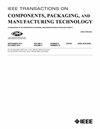Metrology of Warpage in Silicon Wafers Using X-Ray Diffraction Mapping
IF 3
3区 工程技术
Q2 ENGINEERING, ELECTRICAL & ELECTRONIC
IEEE Transactions on Components, Packaging and Manufacturing Technology
Pub Date : 2025-04-04
DOI:10.1109/TCPMT.2025.3557270
引用次数: 0
Abstract
X-ray diffraction (XRD) mapping is a nondestructive metrology technique that enables the reconstruction of warpage induced on a silicon wafer through thermomechanical stress. Here, we mapped the wafer’s warpage using a methodology based on a series of line scans in the用x射线衍射映射法测量硅片翘曲
x射线衍射(XRD)成像是一种无损测量技术,可以通过热机械应力重建硅片上引起的翘曲。在这里,我们使用基于x和y方向上的一系列线扫描以及相同样品的不同90°旋转的方法来绘制晶圆的翘曲。这些线扫描收集了晶圆表面的摇摆曲线(rc),记录了由于表面取向错误而偏离布拉格角的衍射角($\omega $)。在XRD测量中,表面翘曲通过引起测量的衍射角与参考Bragg角($\omega - \omega _{0}$)之间的差异和RC增宽半最大值(FWHM)来反映。通过收集和整合整个表面和晶圆多次旋转的rc和FWHM展宽,我们可以生成表面函数$f(x)$和角取向偏差(warp)的三维图。翘曲呈现凸形,与文献中报道的光学轮廓测量相一致。基于实验室的x射线衍射成像(XRDI)有潜力在更短的时间内原位绘制晶圆的翘曲,因为可以在同步辐射源中完美地执行。
本文章由计算机程序翻译,如有差异,请以英文原文为准。
求助全文
约1分钟内获得全文
求助全文
来源期刊

IEEE Transactions on Components, Packaging and Manufacturing Technology
ENGINEERING, MANUFACTURING-ENGINEERING, ELECTRICAL & ELECTRONIC
CiteScore
4.70
自引率
13.60%
发文量
203
审稿时长
3 months
期刊介绍:
IEEE Transactions on Components, Packaging, and Manufacturing Technology publishes research and application articles on modeling, design, building blocks, technical infrastructure, and analysis underpinning electronic, photonic and MEMS packaging, in addition to new developments in passive components, electrical contacts and connectors, thermal management, and device reliability; as well as the manufacture of electronics parts and assemblies, with broad coverage of design, factory modeling, assembly methods, quality, product robustness, and design-for-environment.
 求助内容:
求助内容: 应助结果提醒方式:
应助结果提醒方式:


